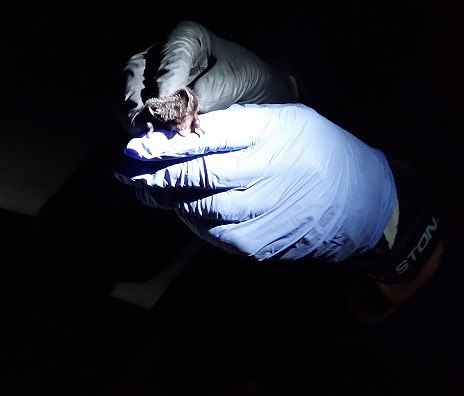Last updated: October 26, 2022
Article
Bats: A Junior Ranger's Perspective

NPS Photo/ J. Gray
You might think bats are just small, mosquito eating machines but, are they really?. Bats are complex animals that are suffering from a disease called Whitenose syndrome. Bats have interesting lives,can live anywhere except the Arctic and eat a lot more than just mosquitoes! It is important to learn about them so we can help them survive while still keeping ourselves and the bats safe. I learned about bats at Agate Fossil Beds National Monument on April 29 and April 30 with two scientists named Caitlyn and Daniel.
Bats are more surprising than they seem. Though most people believe that bats are almost blind they actually are as good as we are at seeing. Maybe even better! Many people think that bat’s ears are only used for echolocation but they are actually used for hearing too. They have good hearing. They also have a good sense of smell which people don’t often think about. Bats have very fragile wings. So they must be able to fly even if their wings are horribly injured. Bats wings heal very fast. For example, we found one that had a broken thumb that was bleeding and a hole in its wing. It flew fine with its wing no longer bleeding. Their wings are also translucent. Bats are very social and often fly in groups. Bats are also outstandingly smart. Some bats use echolocation to navigate and hunt, while others rely on smell and vision to find food. Bats in the UK eat only insects, but bats elsewhere also dine on frogs, fruit, other bats, nectar from flowers, blood, pollen and fish (National Bat Helpline).

NPS Photo/ J. Gray
Some bats are as large as a small dog or as small as a bee (National Bat Helpline). There are two different common kinds of bats at Agate Fossil Beds National Monument. The first one is the Big Brown bat which is bigger than other species of bat in the U.S. Though definitely not the biggest. The biggest is the fruit bat. Big Browns are very brown and quite feisty. The other common bat is the Silver hair. This bat is quite small and quite gray.
You have to be very prepared to catch a bat. To catch a bat the team set up big nets that could catch a bat mid flight. In order to catch a bat, the conditions must be just right. It cannot be too cold or the bats won’t come. It can’t be too late or you’ll miss the bats. Though it can’t be too early or you’ll catch a bird instead. You want to position your net on or near water so you catch them as they are coming up from a drink or down to get one. However, if the water is not calm it might drag the bat under and drown it. So that is another condition you want to watch out for. You want to check your net every ten minutes or the bats will chew its way out. You don’t want to check it any more often than ten minutes or your headlamp’s light will show your net to the bats and they will avoid it. The team uses an echometer to find the bat’s echos.

NPS Photo/ J. Gray
Hibernating bats are suffering from a disease called the Whitenose Sydrome (WNS) which is a fungi called Pseudogymnoascus destructans, or Pd for short. (US Fish and Wildlife) It wakes bats up mid hybernation by eating at their wings and faces. Then the bats grow hungry and starve. Some species of bats are getting hit so hard they are extinct in some places. These include the once numerous little brown bat (Myotis lucifugus) and federally listed Indiana bat (Myotis sodalis) and northern long-eared bat (Myotis spetentronalis). (National Park Service) On the bright side the bats are working on saving themselves by leaving old Pd invested caves and staying away from bats with the syndrome.
Now you must be wondering what the team does with the bats once they are caught. Once they find a bat they stick it in a brown paper bag, roll it up and bring it to the place next to their truck. They measure the bat. If they find bugs called bat bugs, they take them off. The bugs are basically big bed bugs that are attracted to bats. Then they shine their lights through the bat’s wings and look for white spots. Then shine a UV light and look for orange spots. If they find an orange spot it might be the fungi. A common sign of the fungi is when the bat’s muzzle is powdered white.
Today we learned what bats are like, the different kinds, how scientists catch bats, the White-nose syndrome, and what scientists do with the bats. Remember do not do this yourselves because bats can carry rabies. Caitlyn and Daniel are scientists who have the rabies shot and are trained to catch and study bats. Thanks Caitlyn and Daniel for teaching me about bats.
++Written by Ainsley Gray (Age 10)

NPS/ J.Gray
Some of my information came from these sites:
US Fish and Wildlife. (year). What is White-nose Syndrome? Retrieved on 5/10/21 from White-Nose Syndrome.
National Park Service. (Dec 2017). What is White-nose Syndrome? Retrieved on 5/10/21 from What Is White-nose Syndrome? (US National Park Service).
National Bat Headline (year) About bats. Retrieved on 5/11/21 from https://www.bats.org.uk/about-bats
